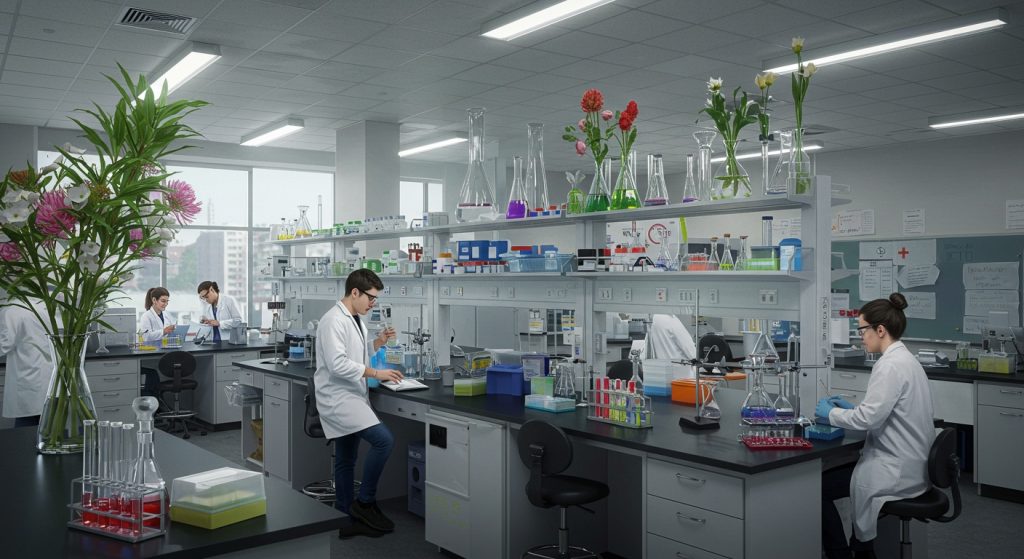Gene editing technologies, particularly CRISPR-Cas9, unlock unprecedented capabilities to rewrite the very blueprint of life, offering revolutionary prospects for eradicating genetic diseases like Huntington’s or cystic fibrosis. This rapid advancement in biotechnology, But, simultaneously confronts humanity with profound ethical dilemmas, moving beyond somatic cell therapy into the contentious realm of germline editing and human enhancement. As researchers push the boundaries of what is technically feasible, the imperative to balance innovation with responsibility becomes critical. Navigating the far-reaching ethical implications of biotechnology demands rigorous societal discourse, ensuring that our pursuit of scientific progress aligns with principles of equity, safety. Human dignity, shaping a future where therapeutic potential avoids unintended, irreversible consequences.

Understanding Gene Editing: A Revolution in Our Hands
Imagine being able to rewrite the very blueprint of life, correcting errors or even adding new instructions with unprecedented precision. This isn’t science fiction; it’s the reality of gene editing. At its core, gene editing involves making targeted changes to an organism’s DNA, the fundamental code that dictates all life processes. Think of our DNA as a vast instruction manual for building and operating a human being. Sometimes, there are typos or missing pages in this manual, leading to genetic diseases like cystic fibrosis, Huntington’s disease, or sickle cell anemia. Gene editing offers the potential to fix these “typos” directly. While various gene editing tools exist, the one that has truly revolutionized the field and brought these ethical considerations to the forefront is CRISPR-Cas9 (Clustered Regularly Interspaced Short Palindromic Repeats and CRISPR-associated protein 9). Discovered as a natural defense system in bacteria, CRISPR-Cas9 acts like a molecular pair of “genetic scissors.” Here’s a simplified breakdown of how it works:
- Guide RNA: A small piece of RNA (a molecule similar to DNA) is engineered to match the specific DNA sequence that needs to be targeted and edited. It acts like a GPS, guiding the system to the precise location in the vast genome.
- Cas9 Enzyme: This is the “scissors.” Once the guide RNA finds its target, the Cas9 enzyme cuts both strands of the DNA at that exact spot.
- Repair Mechanisms: After the cut, the cell’s natural DNA repair machinery kicks in. Scientists can then influence this repair process to either:
- Remove a faulty gene segment.
- Insert a new, correct gene segment.
- Make small changes to alter gene function.
This incredible precision and relative ease of use have opened up possibilities that were once unthinkable. They also bring profound ethical implications of biotechnology into sharp focus.
The Dual Promise: Healing and Enhancing
The power of gene editing presents humanity with a dual promise: the ability to heal and the potential to enhance. On one hand, the therapeutic applications are transformative, offering hope for millions suffering from debilitating diseases. This falls under what’s known as “somatic cell editing,” where changes are made to cells in an individual’s body. These changes are not passed down to their children. Real-world applications in this sphere are already underway, showing incredible promise:
- Sickle Cell Disease: Researchers are using gene editing to correct the genetic mutation responsible for sickle cell disease, allowing patients to produce healthy red blood cells. Clinical trials have shown remarkable success in some patients, effectively “curing” them of the condition by editing their bone marrow cells.
- Duchenne Muscular Dystrophy: Efforts are being made to edit the dystrophin gene, which is mutated in patients with Duchenne, potentially restoring muscle function.
- HIV Resistance: Scientists have explored editing genes to make immune cells resistant to HIV, mimicking a natural resistance found in some individuals.
These therapeutic uses are largely viewed as ethically permissible, as they aim to treat disease and alleviate suffering, much like traditional medicine. But, the “enhancement” aspect of gene editing sparks far greater debate. This involves using gene editing not to cure a disease. To improve traits beyond what is considered “normal” human health. Examples often cited include:
- Increasing muscle mass or athletic performance.
- Boosting cognitive abilities or memory.
- Changing physical characteristics like eye color or height.
The line between therapy and enhancement is not always clear-cut, leading to complex ethical dilemmas. Is preventing a predisposition to a common disease like Alzheimer’s considered therapy or enhancement? What about increasing resistance to common infections? These questions underscore the deep ethical implications of biotechnology.
Somatic vs. Germline Editing: A Critical Distinction
The most profound ethical divide in gene editing lies in the distinction between somatic cell editing and germline cell editing. Understanding this difference is crucial for grasping the ethical implications of biotechnology.
Somatic Cell Editing:
This involves making genetic changes in somatic cells – any cell in the body except for sperm and egg cells. The key characteristic here is that these changes are limited to the treated individual and are not passed down to future generations.
- Purpose: Primarily therapeutic, aimed at treating or curing diseases in an existing patient.
- Reversibility: Changes are not passed on, so if unintended consequences arise, they are confined to the treated individual.
- Ethical Consensus: Generally considered ethically permissible, similar to other forms of medical treatment, provided there’s informed consent and rigorous safety protocols.
Germline Cell Editing:
This involves making genetic changes in germ cells (sperm or egg cells) or in an embryo. The critical difference is that these changes are heritable, meaning they will be passed down to all future generations of that individual’s offspring.
- Purpose: Could be therapeutic (e. G. , preventing a devastating genetic disease from ever appearing in a family line) or for enhancement.
- Reversibility: Irreversible for future generations, making any unintended consequences permanent in the human gene pool.
- Ethical Consensus: Currently, there is a broad international scientific and ethical consensus against clinical germline editing due to profound ethical and safety concerns.
Here’s a comparison to highlight the key differences:
| Feature | Somatic Cell Editing | Germline Cell Editing |
|---|---|---|
| Cells Targeted | Non-reproductive cells (e. G. , blood, muscle, brain cells) | Reproductive cells (sperm, egg) or early embryos |
| Inheritability | Changes are NOT passed to offspring | Changes ARE passed to all future generations |
| Primary Goal | Treat disease in the individual | Prevent disease in future generations; potential for enhancement |
| Ethical Standing | Generally accepted (with safeguards) | Widely considered unethical and unsafe for clinical use currently |
| Scope of Impact | Individual patient | Entire human gene pool for future generations |
The stark reality of germline editing became globally apparent with the controversial case of Chinese scientist He Jiankui in 2018. He announced that he had created the world’s first gene-edited babies, twin girls whose embryos were edited using CRISPR to confer resistance to HIV. This act, performed outside of established ethical guidelines and without sufficient oversight, triggered widespread condemnation from the scientific community and ethicists worldwide. It highlighted the urgent need for robust international dialogue and regulation concerning the ethical implications of biotechnology, especially when dealing with heritable changes to the human genome.
Navigating the Ethical Minefield: Core Concerns
Beyond the somatic vs. Germline debate, gene editing raises a complex web of ethical questions that society must collectively address. These concerns touch upon fundamental aspects of human dignity, societal equity. The very future of our species.
- Equity and Access: The Specter of Genetic Inequality
If gene editing therapies become widely available, who will have access to them? There’s a significant concern that these advanced, potentially expensive treatments could exacerbate existing health disparities, creating a “two-tiered” healthcare system. Only the wealthy might afford to “fix” genetic predispositions or even “enhance” their children, leading to a new form of social stratification – a “genetically privileged” class. This raises questions about distributive justice and whether society has a moral obligation to ensure equitable access to such powerful technologies. - Unintended Consequences: Playing Dice with DNA
Despite CRISPR’s precision, there are risks. “Off-target” edits (unintended changes at other locations in the genome) can occur, potentially leading to unforeseen health problems or even new diseases. Our understanding of the complex interplay of genes is still evolving; altering one gene might have cascading effects we don’t yet comprehend. Moreover, what are the long-term effects of these edits on individuals, or, in the case of germline editing, on the human gene pool? The potential for unknown risks, especially when changes are heritable, demands extreme caution. - The Slippery Slope: From Therapy to Enhancement to a New Eugenics
One of the most frequently voiced concerns is the “slippery slope.” If we allow gene editing to cure serious diseases, where do we draw the line? Will society eventually move towards editing for “desirable” traits like intelligence, athletic prowess, or even aesthetic preferences? This progression could lead to a new form of eugenics, where society implicitly or explicitly pressures individuals to conform to certain genetic ideals, potentially leading to discrimination against those who are “un-edited” or have “undesirable” traits. The historical abuses of eugenics in the 20th century serve as a stark warning. - Human Dignity and Identity: Redefining “Human”
What does it mean to be human? Does altering our fundamental genetic code diminish our inherent dignity or change our identity? Some argue that embracing genetic “perfection” could lead to a loss of appreciation for human diversity and the unique qualities that arise from our natural genetic variations, including those that manifest as disabilities. There’s also the concern about “genetic determinism” – the idea that our genes entirely define us, potentially reducing complex human beings to mere collections of genetic traits. - Informed Consent and Future Generations: Who Decides for the Unborn?
A critical ethical challenge with germline editing is the issue of consent. Future individuals whose genomes are altered by their parents or by society cannot provide informed consent for those changes. This raises profound questions about the rights of future generations and the responsibility of the current generation to protect them from irreversible genetic interventions with unknown long-term consequences.
These are not easy questions. There are no simple answers. They highlight the immense ethical implications of biotechnology and the need for careful, global deliberation.
Real-World Impact and Case Studies
While the ethical debates are intense, it’s vital to acknowledge the tangible progress and hope gene editing offers. In the United States, the Food and Drug Administration (FDA) has approved gene therapies for certain conditions like spinal muscular atrophy and some forms of inherited blindness, though these are typically gene augmentation therapies rather than direct gene editing in the CRISPR sense. But, CRISPR-based therapies are rapidly moving through clinical trials. Consider the ongoing clinical trials for severe genetic blood disorders like sickle cell disease and beta-thalassemia. Patients in these trials, who previously faced debilitating pain, frequent hospitalizations. Shortened lifespans, are showing remarkable improvements, in some cases achieving functional cures. For instance, in trials like CLIMB-121, patients with sickle cell disease have received infusions of their own stem cells, which were gene-edited outside the body to produce a fetal form of hemoglobin, reducing sickling events. These are powerful examples of gene editing’s potential to transform lives. The ethical review process for such trials is incredibly stringent. Institutional Review Boards (IRBs) or Ethics Committees meticulously scrutinize every aspect:
- Patient Safety: Ensuring the potential benefits outweigh the risks.
- Informed Consent: Verifying that patients fully grasp the experimental nature of the therapy, its potential side effects. Alternative treatments.
- Patient Selection: Ensuring fair and equitable criteria for who participates in trials.
- Long-term Monitoring: Planning for years, even decades, of follow-up to track the effects of the gene edits.
These real-world applications demonstrate a responsible approach to somatic cell gene editing, balancing the drive for innovation with robust ethical oversight. The difference in oversight and the global condemnation of the He Jiankui case underscores the critical distinction in the ethical implications of biotechnology when it comes to somatic versus germline interventions. The scientific community, often through bodies like the National Academy of Medicine and the National Academy of Sciences in the U. S. , along with international organizations like the World Health Organization (WHO), has issued clear guidelines emphasizing a cautious and highly restricted approach to germline editing, stressing that it is not yet safe or ethically justifiable for clinical use.
Towards Responsible Innovation: Pathways Forward
Navigating the complex landscape of gene editing requires a multi-faceted approach that prioritizes responsibility alongside innovation. It’s not a question of stopping progress. Rather guiding it thoughtfully and ethically.
- Robust Regulatory Frameworks: Governments and international bodies must develop and enforce clear, adaptable regulations for gene editing technologies. These frameworks need to balance encouraging scientific discovery with protecting individuals and society from potential harms. They should differentiate clearly between somatic and germline editing, setting stringent conditions for the latter, if it is ever deemed permissible in the future.
- International Collaboration and Consensus: Given that genetic changes transcend national borders, global consensus and cooperation are essential. Organizations like the World Health Organization (WHO) and UNESCO have already initiated dialogues and published recommendations, emphasizing the need for global governance, shared ethical principles. Mechanisms to prevent rogue actors from undertaking ethically questionable research, as seen in the He Jiankui case.
- Public Engagement and Education: The ethical implications of biotechnology, particularly gene editing, are too significant to be left solely to scientists and ethicists. Broad public discourse is crucial. Educating the general public about the science, its potential. Its risks empowers individuals to participate in informed discussions, shape policy. Hold decision-makers accountable. Forums, public debates. Accessible educational materials are vital for fostering this understanding.
- The Role of Bioethics Committees: Expert bioethics committees play an indispensable role in providing guidance, evaluating proposals. Advising policymakers. These committees, often multidisciplinary, ensure that diverse perspectives – including those of patients, disability advocates, scientists. Philosophers – are considered when making decisions about sensitive biotechnologies.
- Continuous Dialogue and Adaptability: The field of gene editing is evolving rapidly. What seems impossible or unethical today might change with new scientific discoveries or societal understanding. Therefore, the ethical frameworks and regulatory approaches must be dynamic and adaptable, allowing for continuous review and adjustment based on new evidence and ongoing societal dialogue.
Ultimately, responsible innovation in gene editing means proceeding with humility, foresight. A deep commitment to human well-being. It means fostering an environment where scientific curiosity can flourish. Always within a framework that upholds ethical principles, promotes equity. Protects the fundamental dignity of all humanity.
Conclusion
The ethical landscape of gene editing, particularly with advancements like CRISPR, demands our sustained, nuanced attention. We’ve seen how its immense power, from correcting genetic disorders like sickle cell anemia in research to the controversial prospect of germline edits, underscores the critical balance between scientific progress and societal responsibility. As biotechnological capabilities accelerate, exemplified by ongoing trials for in vivo gene therapies, the need for robust ethical frameworks becomes paramount, rather than an afterthought. My personal tip for navigating this complex domain is to cultivate a habit of interdisciplinary learning. Engage with not just the science. Also philosophy, law. Public policy. I’ve found that understanding diverse perspectives, such as those debated in bioethics commissions globally, truly enriches one’s capacity to contribute meaningfully. It’s about proactive engagement, ensuring that innovation proceeds hand-in-hand with foresight and public trust. Let us collectively strive to shape a future where gene editing serves humanity’s highest good, responsibly and equitably. For more on navigating complex data landscapes, consider exploring Unseen Risks: Data Governance Challenges Posed by Uncategorized Business details.
More Articles
Website Overhaul: Effective Content Strategies for Managing Uncategorized Pages
Conquer Technical Debt: Strategies for Managing Uncategorized Legacy Systems Effectively
Digital Declutter: Smart Strategies to Categorize Your Large Volumes of Files
Project Pitfalls: Tackling Uncategorized Items for Smoother Project Management Success
FAQs
What exactly is gene editing?
Gene editing is a powerful set of technologies that allows scientists to make precise changes to the DNA of living organisms. Think of it like a very advanced cut-and-paste tool for our genetic code. The most well-known method is CRISPR-Cas9, which can be used to add, remove, or alter specific DNA sequences.
Why is everyone talking about the ethics of gene editing so much?
The ethical discussions are intense because gene editing has the potential to fundamentally alter human biology, including changes that could be passed down through generations. It raises deep questions about human identity, what it means to be ‘human,’ and our responsibility to future generations. Unlike many medical interventions, these changes could be permanent and far-reaching.
What are some exciting ways gene editing could help people?
The therapeutic potential is immense! Gene editing could offer cures for devastating genetic diseases like cystic fibrosis, sickle cell anemia. Huntington’s disease. It might also be used to make people resistant to infections like HIV or even to develop new ways to fight cancer. Beyond human health, it could improve agriculture by creating more resilient crops.
What are the big ethical red flags we need to watch out for?
Key concerns include the possibility of unintended side effects or ‘off-target’ edits, the risk of creating a ‘designer baby’ scenario where editing is used for non-medical enhancements rather than treating disease. The potential for increased societal inequality if these technologies are only accessible to the wealthy. There are also worries about impacts on human diversity and autonomy.
What’s the fuss about ‘germline’ versus ‘somatic’ gene editing?
This is a crucial distinction! Somatic gene editing involves making changes to cells that are not passed down to offspring (like treating a disease in an adult’s lung cells). These changes only affect the treated individual. Germline gene editing, on the other hand, involves editing sperm, egg, or embryo cells, meaning the changes would be inherited by all future generations. Germline editing is far more controversial due to its permanent and inheritable nature.
Who gets to decide what’s allowed and what’s not in gene editing?
There’s no single global authority. Decisions are being shaped by a complex interplay of scientists, ethicists, governments, patient advocacy groups. Public opinion. Many countries are developing their own regulations and guidelines, often influenced by international discussions and consensus reports from bodies like the World Health Organization and national academies of science. It’s a rapidly evolving landscape requiring continuous dialogue.
How can we make sure gene editing is used wisely and not for harmful things?
Ensuring responsible use requires a multi-faceted approach. This includes establishing robust ethical frameworks and strong regulatory oversight, fostering public engagement and transparency about research, promoting international cooperation to prevent rogue actors. Focusing initial applications strictly on serious medical conditions rather than enhancements. Ongoing societal dialogue and adaptive governance will be key to navigating this powerful technology responsibly.



